This chapter focuses on three groups of U.S. adults, based on their answers to the following four questions: Do you think of yourself as spiritual? Do you think of yourself as religious? How important is spirituality in your life? How important is religion in your life?
The three groups are:
- 22% of Americans who are categorized as spiritual but not religious (SBNR) because they say they think of themselves as spiritual or they consider spirituality very important in their lives, but they neither think of themselves as religious nor say religion is very important in their lives.
- 58% of Americans who fall into an overall or “NET” Religious category because they say they think of themselves as religious or they consider religion very important in their lives. This group can be subdivided into U.S. adults who are both religious and spiritual (48%) and those who are religious but not spiritual (10%)
- 21% of Americans who are categorized as neither spiritual nor religious because they don’t think of themselves as spiritual, don’t think of themselves as religious, don’t consider spirituality very important in their lives and don’t consider religion very important in their lives.
Most of the comparisons in this chapter are between the SBNR and the NET Religious categories. Compared with religious Americans, SBNRs tend to be younger, more likely to identify as Democrats or Democratic-leaning independents and less likely to affiliate with a religion.
SBNRs also differ from religious Americans on some key measures of belief and practice analyzed in this report. For example, SBNRs are far more likely than religious adults to say they believe that spirits or spiritual energies can be contained in animals other than humans (78% vs. 54%) or in parts of nature like mountains, rivers or trees (71% vs. 45%).
On the other hand, SBNRs are less likely than religious adults to believe in God as described in the Bible (20% vs. 82%), pray daily (21% vs. 64%) or attend religious services at least once a week (2% vs. 36%.)

Still, SBNRs hold many beliefs in common with religious Americans. For example, most people in both groups believe that there is something spiritual beyond the natural world, even if we cannot see it (88% of SBNRs and 92% of the religious) and that human beings have a soul or spirit in addition to their physical body (89% and 92%, respectively).
This chapter discusses these findings in more detail and shows how SBNR Americans and religious Americans differ on some measures presented in previous chapters.
Demographic characteristics
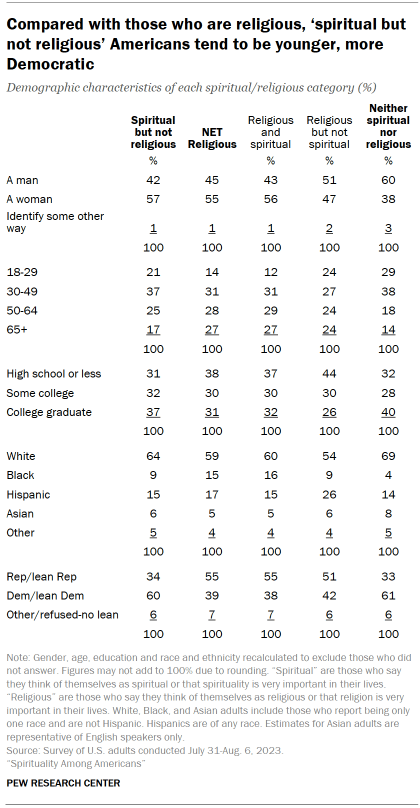
Compared with religious adults, SBNRs are relatively young (58% of adult SBNRs are under age 50, compared with 45% of religious Americans) and more likely to identify as Democrats or Democratic-leaning independents (60% vs. 39%).
SBNRs and religious Americans are similar in their gender composition, with women accounting for a slight majority in each group.
Demographically, Americans who are neither spiritual nor religious stand out for being comprised predominantly of men (60%).
When it comes to religious identification, SBNR Americans are divided between affiliating with a religion (45%) and not affiliating with one (54%).
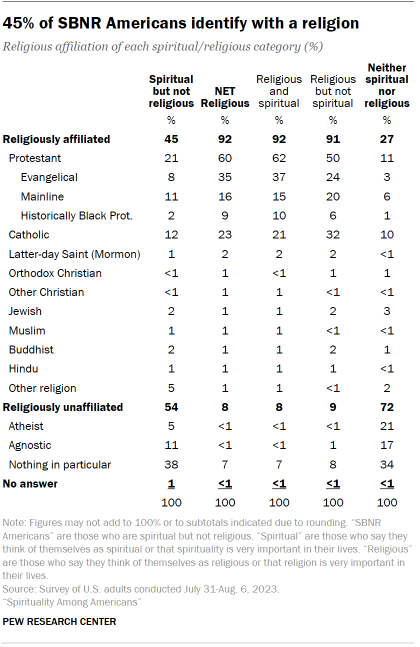
By contrast, the vast majority of religious Americans identify with a religion (92%), while most adults who are neither spiritual nor religious are religiously unaffiliated (72%).
The most common response that SBNR Americans give when asked to select a religious identity is “nothing in particular” (38%). About one-fifth of SBNRs identify as Protestant, and 12% identify as Catholic.
Spiritual beliefs and practices
Some spiritual beliefs are widely shared by SBNRs and religious U.S. adults. For example, large shares of both SBNRs (89%) and religious Americans (92%) say they believe people have a soul or spirit in addition to their physical body. Most people in both groups also say that there is something spiritual beyond the natural world, even if we cannot see it (88% and 92%) and that spirits or unseen spiritual forces exist (72% and 74%).
However, SBNRs are somewhat less likely than religious Americans to say there are some things that science cannot possibly explain (74% vs. 85%).

Beliefs on where spirits reside

SBNRs are far less likely than religious Americans to believe in God as described in the Bible (20% vs. 82%). Instead, they are much more likely to say they believe there is “some other higher power or spiritual force in the universe” (73% vs. 16%).
Also, SBNR Americans are more likely than religious Americans to say that animals, memorial sites, parts of nature or certain objects can have spirits or spiritual energies.
For example, 78% of SBNR Americans say that spirits or spiritual energies can reside in animals other than humans, compared with 54% of religious adults. And 71% of SBNR adults say spirits can reside in parts of nature like mountains, rivers or trees, compared with 45% of religious adults who hold this view.
Fewer SBNRs say that objects like crystals, jewels or stones can have spirits or spiritual energies (42%). But that share is still larger than among religious Americans (24%).
Beliefs about the afterlife

SBNR Americans are much less likely than religious Americans to say they believe in heaven (54% vs. 93%) or hell (40% vs. 83%). But SBNRs are much more likely than Americans who are neither spiritual nor religious to believe in heaven and hell.
SBNRs also stand out for their beliefs about reincarnation: 43% say it is definitely or probably true that people who have died can be reborn again in this world, compared with 24% of religious Americans who express the same view.
And there are some differences on other questions about the afterlife. For example, SBNRs are less likely than religious Americans to say that after people die, they definitely or probably can be reunited with loved ones who have already died (56% vs. 69%.)
But both SBNRs and religious Americans are much more likely than those who are neither spiritual nor religious to say that people who have died can be aware of things going on among the living, can communicate with the living and can help or harm the living.

Spiritual practices
Nearly six-in-ten “spiritual but not religious” Americans (58%) say they spend time looking inward or centering themselves at least a few times a month mainly for connection, including 43% who do so primarily to connect with their “true self.” Fewer religious Americans and those who are neither spiritual nor religious say the same.

SBNRs are also more likely than religious Americans and those who are neither spiritual nor religious to report that they spend time in nature at least a few times a month for connection, especially in order to connect with something bigger than themselves.
But SBNRs are as likely as religious-and-spiritual Americans to say they meditate at least a few times a month primarily to foster connections (28% each).
The new survey also asked whether people have a variety of things for spiritual purposes. SBNRs are notably less likely than religious Americans to say they have a cross (21% vs. 51%). But SBNRs are much more likely to say they own crystals (25% vs. 9%) and somewhat more likely to have a tattoo or piercing for spiritual purposes (15% vs. 9%). SBNRs and religious Americans are about equally likely to have a shrine, altar or icon in their home or to have jewelry for spiritual purposes.
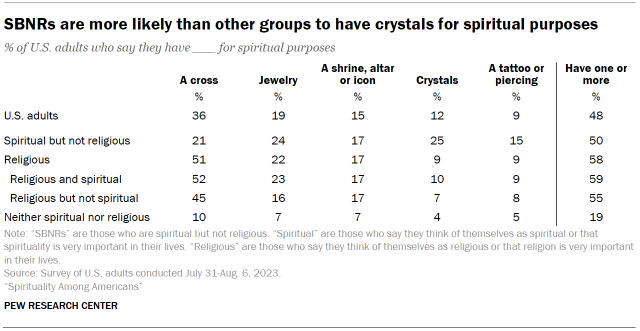
Involvement in communities
The survey asked respondents whether they are involved in three kinds of communities: a religious community “such as a church or religious congregation”; a spiritual community “such as a group that helps you find a connection with something bigger than yourself, nature or other people”; or a “nonreligious volunteer or community service group.” Respondents could indicate they belong to all, some or none of these kinds of communities.
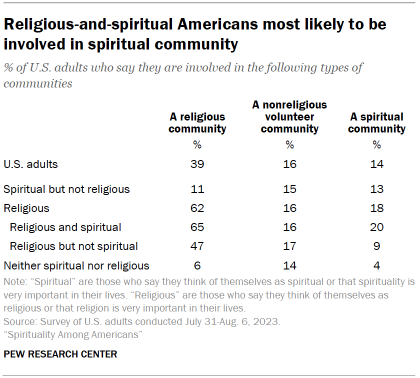
SBNRs are much less likely than religious Americans to say they are involved in a religious community (11% vs. 62%). They are also slightly less likely to be involved in a spiritual community (13% vs. 18%), though that difference masks a split within the religious category: Americans who are both religious and spiritual are much more likely than those who are religious but not spiritual to say they are involved in a spiritual community (20% vs. 9%).
Meanwhile, the survey finds no significant difference between SBNRs and religious Americans, overall, in their propensity to be involved in a nonreligious volunteer or community service group.
Spiritual experiences

SBNRs are more likely than religious Americans (and U.S. adults as a whole) to have had a strong feeling that someone who has passed away was communicating with them from beyond this world: 48% of SBNRs say they have ever had such an experience, compared with 41% of religious Americans and 21% of U.S. adults who are neither spiritual nor religious.
SBNRs are also slightly more likely than religious Americans to say they have ever had a sudden feeling of connection with “something from beyond this world” (55% vs. 49%), but there is a substantial divide within the religious category: 52% of Americans who are both religious and spiritual say they have had such an experience, compared with 32% of those who are religious but not spiritual.

The same patterns hold when comparing SBNRs with religious Americans on some other questions about experiences that might be considered spiritual. SBNRs are more likely than religious Americans (and much more likely than those who are religious but not spiritual) to say they feel a deep sense of wonder about the universe once a month or more often.
On the other hand, SBNRs are somewhat less likely than religious Americans (and much less likely than those who are both religious and spiritual) to say they feel a deep sense of spiritual peace and well-being at least monthly.
(Chapter 4 shows the percentage of U.S. adults who report having these experiences at least a few times a year, rather than monthly or more often.)
Change in personal spirituality over time
Most SBNRs say they have become less religious over the course of their lifetimes (59%). At the same time, 49% say they have become more spiritual over the years and 28% say their spirituality has fluctuated, sometimes increasing and other times decreasing.
By contrast, religious Americans are more likely to say that during their lifetimes, they have become more religious (40%) than to say they have become less religious (14%). Many religious Americans say they have either stayed about the same religiously (19%) or gone back and forth, sometimes becoming more religious and sometimes less (26%).
And religious Americans are just as likely as SBNRs to say they have become more spiritual over their lifetimes: 50% of religious Americans and 49% of SBNRs say this about themselves, while much smaller shares of both groups say they have become less spiritual (5% of religious Americans, 6% of SBNRs).

Religion and society
Spiritual but not religious Americans, along with those who are neither spiritual nor religious, are more critical than religious adults of religion’s impact on society. On balance, 38% of SBNRs say religion does more harm than good, while just 7% of religious Americans share this view.

SBNRs are also more likely than religious Americans to say that the statement “religion causes division and intolerance” describes their views a great deal (42% vs. 11%).
And SBNR Americans are less likely than religious adults to take the position that “religion encourages people to do the right thing and treat people well” (13% vs. 54%) and that “religion helps society by giving people meaning and purpose in their lives” (15% vs. 53%).
What does ‘spiritual’ mean?
This survey also asked respondents to say, in their own words, what the term “spiritual” means to them. We categorized their responses based on the types of beliefs, experiences or other concepts they mentioned.
- 14% of SBNRs give descriptions tied to organized religion, compared with 36% of religious adults.
- About one-in-ten SBNRs relate spirituality to things outside of organized religion, compared with 2% of religious Americans.
- 43% of SBNRs offer responses that mention beliefs in what we categorized as “something else,” such as belief in a higher power (18%) or belief in the unseen or otherworldly (9%). Among religious adults, 27% relate spirituality to beliefs in “something else.”
- A sizable share of SBNRs (27%) also explain the term “spiritual” by referring to connections, such as with God, nature, their inner self or humanity in general. And 15% say “spiritual” relates to understanding themselves or guiding their own behavior, such as being kind or respectful.

Essential elements of spirituality
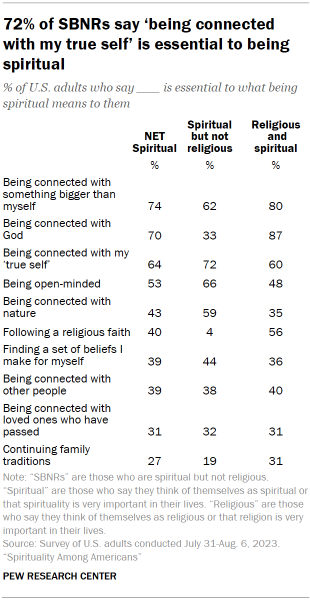
To further gauge how Americans think about spirituality, the survey asked those who are spiritual whether each of 10 items are “essential,” “important, but not essential,” or “not an important part” to what being spiritual means to them. And a follow-up question asked whether there is anything else they consider essential to what being spiritual means to them (refer to the Topline for responses).
Most Americans who are spiritual but not religious say that “being connected with my true self” is essential to being spiritual (72%). Majorities also say “being open-minded” (66%), “being connected with something bigger than myself” (62%) and “being connected with nature” (59%) are essential.
Religious-and-spiritual Americans, on the other hand, are most likely to say “being connected with God” is essential to being spiritual.




